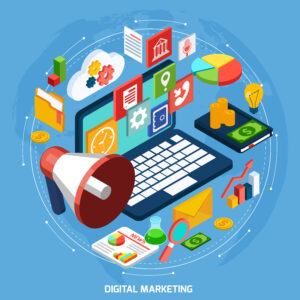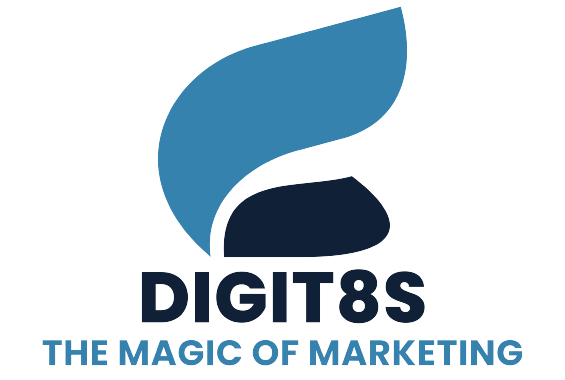Blog
Introduction
In today’s digital age, businesses must adapt and thrive in the online world to reach their target audience effectively. Digital marketing has emerged as a powerful and essential tool for businesses to promote their products and services, connect with their audience, and drive growth. In this comprehensive guide, we will delve into what digital marketing is, explore various strategies and tools, and highlight the latest trends that shape this dynamic field.
What Is Digital Marketing?
Digital marketing is a multifaceted approach to promoting products, services, or brands using digital channels and technologies. It encompasses various online platforms, such as websites, social media, email, search engines, and mobile apps, to connect with potential customers and build lasting relationships. Unlike traditional marketing, digital marketing leverages the internet’s vast reach, interactivity, and data-driven insights to deliver targeted and measurable results.

Key Components of Digital Marketing
- Search Engine Optimization (SEO): SEO is the practice of optimizing a website’s content and structure to improve its visibility in search engine results pages (SERPs). The goal is to increase organic (non-paid) traffic to a website by ranking higher for relevant keywords. This involves on-page optimization, off-page optimization, and technical SEO.
- Content Marketing: Content marketing involves creating and distributing valuable, relevant, and consistent content to attract and engage a target audience. Content can take various forms, including blog posts, videos, infographics, and ebooks. The objective is to establish authority, build trust, and drive conversions.
- Social Media Marketing: Social media marketing is the use of social platforms like Facebook, Twitter, Instagram, and LinkedIn to connect with a brand’s audience. It involves creating and sharing content, running paid ads, and engaging with followers to build brand awareness, drive traffic, and foster customer loyalty.
- Email Marketing: Email marketing is a direct communication channel with potential and existing customers. Businesses send emails to inform, educate, and promote products or services. Effective email marketing campaigns rely on segmentation, personalization, and automation to achieve higher open and click-through rates.
- Pay-Per-Click Advertising (PPC): PPC advertising allows businesses to display ads on search engines and other online platforms. Advertisers pay a fee each time a user clicks on their ad. It is a highly targeted method for driving traffic and conversions, with platforms like Google Ads and Facebook Ads dominating the space.
- Affiliate Marketing: Affiliate marketing involves partnering with other businesses or individuals (affiliates) to promote your products or services. Affiliates earn a commission for each sale or lead generated through their marketing efforts. It is a performance-based marketing model.
- Influencer Marketing: Influencer marketing leverages the popularity and credibility of social media influencers or content creators to promote products or services. Brands collaborate with influencers who align with their target audience to reach a broader and engaged customer base.
- Online Public Relations (PR): Online PR focuses on managing a brand’s reputation and online presence through strategies like online press releases, media outreach, and crisis management. It helps maintain a positive brand image and handles any negative publicity effectively.
- Analytics and Data Analysis: Data is at the heart of digital marketing. Businesses use analytics tools to track and analyze various metrics such as website traffic, conversion rates, social media engagement, and email campaign performance. These insights guide decision-making and optimization efforts.
Digital Marketing Strategies
Effective digital marketing requires a well-planned strategy that aligns with your business goals. Here are some key strategies:
- Define Your Audience: Understanding your target audience is crucial. Create detailed buyer personas to identify their needs, preferences, and pain points. This knowledge will inform your content and advertising strategies.
- Set Clear Objectives: Establish specific, measurable, achievable, relevant, and time-bound (SMART) goals for your digital marketing campaigns. Whether it’s increasing website traffic, generating leads, or boosting sales, clear objectives keep your efforts focused.
- Content Marketing Strategy: Develop a content marketing plan that outlines the type of content you will create, the channels you will use to distribute it, and the frequency of publication. Ensure that your content provides value to your audience and aligns with your brand’s voice and message.
- SEO Optimization: Implement SEO best practices to improve your website’s search engine rankings. Conduct keyword research to identify relevant keywords, create high-quality content, and optimize on-page elements such as titles, meta descriptions, and headings.
- Social Media Engagement: Build a strong social media presence by posting regularly, engaging with your audience, and sharing valuable content. Use analytics to determine the best times to post and the most effective content types.
- Email Marketing Campaigns: Craft personalized email campaigns that cater to different segments of your audience. Use automation to send triggered emails based on user behavior, such as abandoned cart reminders or product recommendations.
- Paid Advertising: Invest in paid advertising campaigns, such as PPC and social media ads, to drive targeted traffic to your website. Set budgets, choose relevant keywords, and continuously monitor and optimize your campaigns for better results.
- Conversion Rate Optimization (CRO): Optimize your website and landing pages to increase conversion rates. Test different elements, such as headlines, images, and call-to-action buttons, to identify what resonates best with your audience.
- Incorporate Video: Video content has become increasingly popular. Consider incorporating video marketing into your strategy, whether it’s through tutorials, product demonstrations, or behind-the-scenes glimpses of your company.
- Mobile Optimization: Ensure that your website and content are mobile-friendly, as a significant portion of internet traffic comes from mobile devices. Google’s mobile-first indexing also prioritizes mobile-optimized websites.
Digital Marketing Tools
To execute your digital marketing strategies effectively, you’ll need a toolkit of various tools and platforms. Here are some digital marketing essential ones:
- Content Management Systems (CMS): Popular CMS platforms like WordPress, Drupal, and Joomla make it easy to create and manage website content.
- Email Marketing Software: Platforms like Mailchimp, HubSpot, and SendinBlue help you design, automate, and analyze email campaigns.
- SEO Tools: Tools like SEMrush, Ahrefs, and Moz provide keyword research, backlink analysis, and on-page SEO optimization features.
- Social Media Management Tools: Tools like Hootsuite, Buffer, and Sprout Social streamline social media posting and analytics.
- Analytics Platforms: Google Analytics and Google Search Console offer in-depth insights into website performance and search engine rankings.
- Advertising Platforms: Google Ads, Facebook Ads Manager, and LinkedIn Advertising enable you to run paid advertising campaigns.
- Content Creation Tools: Canva, Adobe Creative Cloud, and Snappa help create engaging visuals and graphics for content.
- Email Automation Tools: Platforms like HubSpot, ActiveCampaign, and Marketo offer advanced automation and personalization features.
- Video Editing Software: Tools like Adobe Premiere Pro and Final Cut Pro are ideal for creating professional video content.
- Customer Relationship Management (CRM) Software: CRMs like Salesforce, HubSpot CRM, and Zoho CRM help manage customer relationships and track interactions.
Digital Marketing Trends
The digital marketing landscape is continually evolving, driven by technological advancements and changing consumer behaviors. Staying updated with the latest trends is crucial for staying competitive. Here are some trends to watch out for in digital marketing:
- Artificial Intelligence (AI) and Machine Learning: AI-powered tools and algorithms are being used for personalization, chatbots, content generation, and data analysis, making marketing campaigns more efficient and targeted.
- Voice Search Optimization: With the rise of voice-activated devices like Amazon Echo and Google Home, optimizing content for voice search is becoming essential.
- Video Marketing Dominance: Video content, particularly short-form video on platforms like TikTok and Instagram Reels, is gaining popularity. Live streaming and interactive video experiences are also on the rise.
- User-Generated Content (UGC): Encouraging customers to create and share content related to your brand can build trust and authenticity. UGC can be leveraged in marketing campaigns.
- Privacy Concerns and Data Protection: As data privacy regulations like GDPR and CCPA gain prominence, businesses need to prioritize data security and transparency in their digital marketing practices.
- Ephemeral Content: Stories on platforms like Instagram and Snapchat provide opportunities for time-limited, authentic, and engaging content.
- Content Experience: Focus on creating exceptional content experiences, including interactive content, immersive storytelling, and personalized content journeys.
- Local SEO: With the growth of “near me” searches, optimizing for local SEO is crucial for brick-and-mortar businesses.
- Sustainability and Social Responsibility: Consumers are increasingly drawn to brands that prioritize sustainability and social responsibility. Digital marketing can communicate these values effectively.
- Augmented Reality (AR) and Virtual Reality (VR): AR and VR technologies are being used for interactive product experiences and virtual showrooms.
Conclusion
Digital marketing is a dynamic and essential component of modern business strategies. It offers a wide range of strategies, tools, and trends that can help businesses connect with their audience, drive growth, and adapt to evolving consumer behaviors. By understanding the key components, formulating effective strategies, utilizing the right tools, and staying updated with the latest trends, businesses can harness the power of digital marketing to achieve their goals in the ever-expanding online marketplace.
